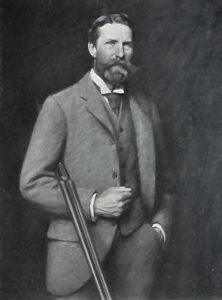Top Qs
Timeline
Chat
Perspective
Edmund Giles Loder
English aristocrat, landowner and plantsman From Wikipedia, the free encyclopedia
Remove ads
Sir Edmund Giles Loder, 2nd Baronet (7 August 1849 – 14 April 1920) was an English aristocrat, landowner and plantsman.
Remove ads
Biography
Summarize
Perspective
Early life
Edmund Giles Loder was born on 7 August 1849 in London, England.[1][2] His father was Sir Robert Loder, 1st Baronet, a landowner and Conservative politician, and his mother, Maria Georgiana Busk. His maternal grandfather was Hans Busk, a Welsh poet.
He was educated at Eton College, a private boarding school in Eton, Berkshire, and graduated from Trinity College, a constituent college of the University of Cambridge. When at Eton he competed in the 100 yards event at the AAC Championships, winning the silver medal at the 1869 AAC Championships.[3][4]
Career
He served as a Justice of the Peace for Sussex and Northampshire.
Loder was active as a plant collector, breeder and grower. He developed hybrid rhododendrons from crosses between R. fortunei and R. griffithianum. The plants were named the Loderi hybrids and group in his honour. Three, Loderi King George, Loderi Pink Diamond and Loder's White, have received the Award of Garden Merit from the Royal Horticultural Society. He developed the garden at his home at Leonardslee extensively.[5]
Personal life
Loder was a member of the Loder family
He married Marion Hubbard, daughter of William Egerton Hubbard. They had two children:
- Patience Marion Loder (1882–1963). She married Walter William Otter (unknown-1940).
- Robert Egerton Loder (1887–1917). He married Muriel Rolls Hoare (1879–1955). They had one son:
- Sir Giles Rolls Loder, 3rd Baronet (1914–1999).
They resided at Beach House in Worthing, West Sussex.[6] During his visits to Brighton, King Edward VII (1841–1910) would spend time in the garden at Beach House with his friend Arthur Sassoon (1840–1912).[6] They also resided at Leonardslee in Lower Beeding near Horsham in West Sussex.
Natural history collection
Loder kept a menagerie in the grounds of Leonardslee, the family ancestral home in Sussex. Many of the animals were made into osteology specimens, and 200 skulls and skeletons are now are in the collection of World Museum, National Museums Liverpool, being presented to the museum in 1961.[7] A number of the game heads from Loder's museum are in Rowland Ward's Records of Big Game.[8] These were accumulated through Loder's hunting expeditions, but also purchase.[8]
Remove ads
Bibliography
- Conifers at Leonardslee (1919).
- Edmund Loder: A memoir, with a portrait (with Sir Alfred Pease, 2nd Baronet, 1923).
References
Wikiwand - on
Seamless Wikipedia browsing. On steroids.
Remove ads

